
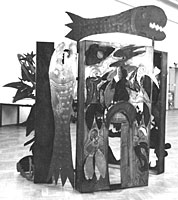 In archaic Greek the word 'apocalypsis' meant 'revelation'. In later usage this meaning developed into 'revelation of the end of history', as it is used in the last book of the Bible: the Revelation of St. John the Divine. This aspect of meaning then became a classical theme in the history of art. Apocalyptic works by among others Dürer, Chagall and Picasso are well - known.
In archaic Greek the word 'apocalypsis' meant 'revelation'. In later usage this meaning developed into 'revelation of the end of history', as it is used in the last book of the Bible: the Revelation of St. John the Divine. This aspect of meaning then became a classical theme in the history of art. Apocalyptic works by among others Dürer, Chagall and Picasso are well - known.
The book St. John wrote was originally meant to offer consolation to the Christians who were severely prosecuted by the Roman emperors. Thevisions John received through divine inspiration showed that the just eventually will be saved from chaos and extermination.
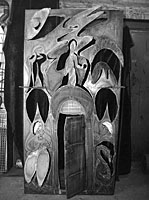 The visual images which were used in this last book of the Bible kept recurring in the history of western art. Especially interesting are the medieval versions of the Apocalypse like the Spanish one made under Arabic influence by Garcia Placidus, to which Beatus added his commentary.
The visual images which were used in this last book of the Bible kept recurring in the history of western art. Especially interesting are the medieval versions of the Apocalypse like the Spanish one made under Arabic influence by Garcia Placidus, to which Beatus added his commentary.
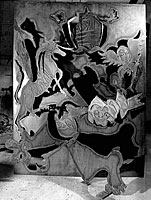 Prinsen's Apocalypse shows traces of this iconography of the theme (references to Picasso's Guernica and medieval apocalyptic art). But first and foremost it reflects fears caused by the problematic situation at the turn of the 20th century: destruction and exhaustion of natural resources, climate change, a global turbo-pirate economy and the threat of mass destruction through thermonuclear and/or biological weapons.
Prinsen's Apocalypse shows traces of this iconography of the theme (references to Picasso's Guernica and medieval apocalyptic art). But first and foremost it reflects fears caused by the problematic situation at the turn of the 20th century: destruction and exhaustion of natural resources, climate change, a global turbo-pirate economy and the threat of mass destruction through thermonuclear and/or biological weapons.
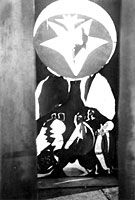 The work consists of three rectangular panels enclosing a triangular space. The fire of the oxyacetylene cutter cut the apocalyptic story of fear and hope into the metal plates. The globe and its 'lungs' for instance refer not only to environmental catastrophe but also to the breath of life symbolised by the Holy Spirit. An opened door is alluding to the gate of hope through which positive transformational energies can flow into the world.
The work consists of three rectangular panels enclosing a triangular space. The fire of the oxyacetylene cutter cut the apocalyptic story of fear and hope into the metal plates. The globe and its 'lungs' for instance refer not only to environmental catastrophe but also to the breath of life symbolised by the Holy Spirit. An opened door is alluding to the gate of hope through which positive transformational energies can flow into the world.
Two huge fish - symbolising Christ - constitute the connecting 'messianic' link in the construction.
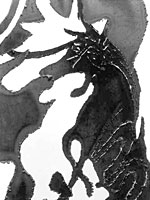 |
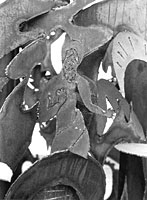 |
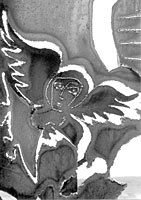 |
Website © Irène Prinsen, visitors of this site are reminded that the exhibited works and commentaries are subject to copyright law. For use of works of visual artists affiliated with a CISAC-organisation, other than consultation via Internet, permission is required from Pictoright, visuele auteursrechten Nederland.